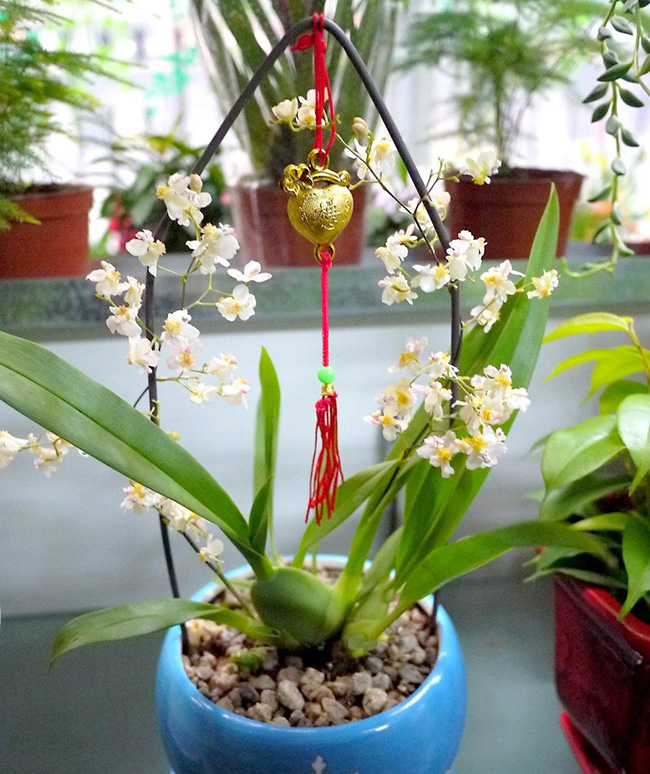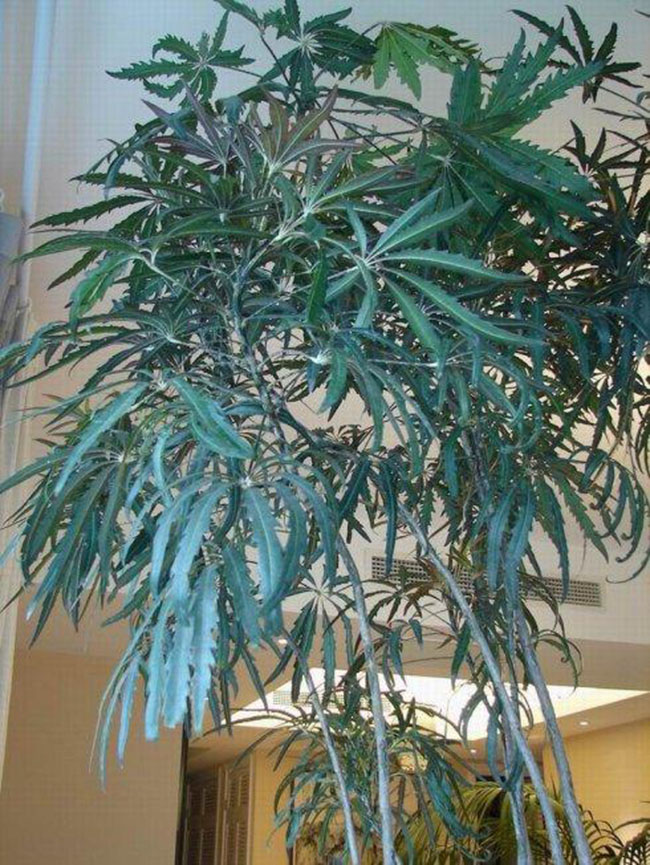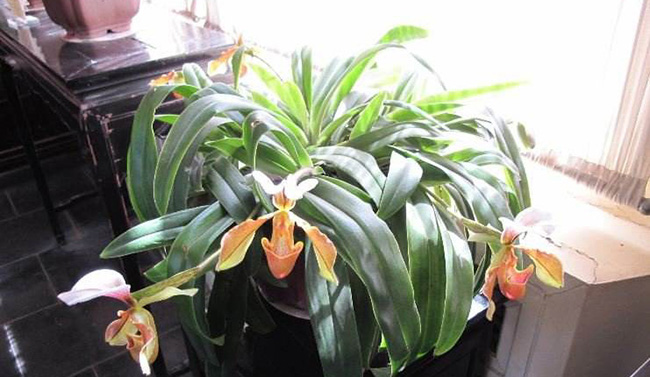Culture methods and matters needing attention of Oncidium
Oncidium encyclopedia, also known as auspicious orchid, dance orchid, dance girl orchid, golden butterfly orchid, tumor orchid, etc., with 1 to 3 leaves, which can be divided into thin leaf species, thick leaf species and sword leaf species. The general name of Oncidium in Orchidaceae, there are more than 750 native species in the world, but most of the varieties used commercially are hybrids, the plants are light and chic, the flower stems are light and drooping, the flowers are strange and lovely, similar to the flying golden butterfly, very dynamic, and is one of the most important potted and cut flowers in the world. Its story is far-reaching. It is said that when Soong Meiling visited the White House, she fell in love with this flower at first sight and found that the petals were very much like the word "auspicious" in Chinese characters, implying auspiciousness, so it was named "auspicious Orchid".

Oncidium growing environment
Air temperature condition
Oncidium is native to the United States, Mexico, Guyana and Peru. The original leaf type (or hard leaf type) Oncidium prefers warm and hot environment, while thin leaf type (or soft leaf type) and sword leaf type Oncidium prefer cool climate. The optimum temperature for the growth of thick-leaf Oncidium is 18-25 ℃, and the winter temperature is not lower than 12 ℃. The suitable temperature for the growth of thin leaf type is 10: 22 ℃, and the winter temperature is not lower than 8 ℃.
Environmental condition
Oncidium prefers moist and semi-shady environment, in addition to watering to increase substrate humidity, leaf surface and ground water spraying is more important, increasing air humidity is more beneficial to the growth of leaves and flower stems. Hard leaf varieties have strong drought tolerance, and dry death does not occur without watering for a long time in winter.
Strong endurance
Phenomenon, its endurance is very strong. Large-scale production requires a sunshade net, with a shading rate of 40% to 50%. Sufficient sunshine is needed in winter, generally without sunshade net, which is beneficial to flowering. The main value of Oncidium
Cut flower variety
Oncidium is a kind of orchid which is very beautiful and of great ornamental value. it is one of the important cut orchid varieties in the world. It can be bottled at home and office. It is also a high-grade flower material for processing bouquets and small baskets. It is now cultivated all over the world. Dancing orchid is Oncidium, it has a bright yellow, every flower, like a beautiful girl, skirt fluttering, dancing, its flower language is happy and worry-free, meaning to forget worry.
Ornamental value
Oncidium is an extremely beautiful and ornamental orchid. It is one of the most important cut orchid varieties in the world. It is suitable for vase placement in family rooms and offices, and is also a propagation method of high-grade flower material Oncidium for processing bouquets and small flower baskets.
Ramet propagation
Oncidium is a compound-stemmed orchid, which will grow into a seed plant after it is grown up, and can be cut off from the mother plant when it has a pseudobulb. Cut off the false bulb with 2 buds and plant it directly in the basin of water moss to maintain high air humidity and quickly restore new buds and roots. Ramet propagation is generally carried out after flowering or in spring and autumn, and it is best to combine with changing pots before new buds germinate in spring.
Culture method of Oncidium
1. Soil:
Oncidium likes a relatively dry environment. When breeding, we can spread some broken bricks or rubble on the bottom of the basin, and the culture medium had better choose a breathable medium. We can use 4 parts of crushed fern root, 1 part of peat soil, 2 parts of broken charcoal, 2 parts of vermiculite and 1 part of water moss.
2. Lighting:
Oncidium belongs to a semi-shady plant. Generally speaking, we should let the sun shine on it directly in winter, which is beneficial to the flowering of Oncidium. However, in other seasons, shading measures should be done to avoid leaf burns, shading is probably the best.
3. Temperature:
Oncidium is generally not suitable for growing in a relatively low temperature environment, so it is recommended that the lowest growth temperature of Oncidium should not be lower than 12 ℃, the suitable growth temperature of Oncidium should be 18-25 ℃, and the growth temperature of thin-leaf species of Oncidium should be no less than 8 ℃, and the suitable growth temperature is 10-22 ℃.
4. Moisture:
Oncidium prefers to be dry, so we should water thoroughly when the soil surface is already dry. We can increase the amount of water in the growing season, and it is more appropriate to water it in the morning and evening. Of course, if it is winter, we should strengthen the amount of water and the frequency of watering. This will promote flowering and stop watering when the temperature is below 10 ℃.
5. Fertilization:
Apply a compound fertilizer with a low concentration of nitrogen: phosphorus: potassium at 1:1:1 every 20 days from spring to autumn, or spray leaves with a concentration of 0.05% to 0.1%. Do not apply fertilizer when the temperature is low in winter. Matters needing attention in culture
The main results are as follows: 1. the cultivation materials are made of tree ferns and oil-free hardwood in hot and humid places, while in dry places, water moss fern roots and moss can be planted in porous pots.
2. The daily management of Oncidium is generally not very strict to the environment.
3. We usually follow the principle of watering dry and wet, watering every day in summer, and sprinkling water in leaves and pots to increase humidity and cool down. Watering needs to be reduced in winter, construction is carried out 2 to 3 times a month during the growing period, and fertilization needs to be stopped in winter.
4. 30% of the light should be shaded in spring and autumn and 50% to 70% in summer, but not in too dark places, lest the growth of branches and leaves will affect the beauty.
5. It is necessary to change the basin and replace the new culture medium every year. Fertilizer and water management in aquaculture
Fertilizer and water management of seedlings
After fully washing the seedlings, the dry water moss was used as the substrate and planted in the plastic soft cup of 3cm, and the disease prevention was sprayed with 65% good life 1000 times solution mixed with 72% agricultural streptomycin sulfate 3000 times solution on the same day after planting. When the water plant in the basin is dry, pour half the water with clear water to make the water plant moist. After about 15 days, new roots begin to grow, which can be irrigated with 20-20-20 Peter fertilizer 3000 times, once a week.
Fertilizer and water management in medium and large basin
After 3-4 months, the seedlings grew to 4-6 pseudo-bulbs, the roots were dense, and some of the roots grew out of the pot, so the pot should be changed at this time. When changing the basin, first remove the seedling from the basin and put it in a plastic basin with a small amount of charcoal at the bottom, and then add an appropriate amount of charcoal block around the plant. After 5-6 months, the seedling grows to 6-8 pseudo-bulbs, and the root system wraps the charcoal block very well. At this time, the basin should be changed for the middle seedling.
Fertilizer and water management of medium and large seedlings
Seedlings and medium seedlings should be sprayed once on the day of basin change, the mixture of 1000 times of 65% Haoshengling and 3000 times of agricultural streptomycin sulfate should be sprayed to prevent the disease, and watered once 3-5 days after planting. As the watering times should be increased and foliar water should be sprayed once a day in summer, autumn and dry weather, foliar water should be sprayed every 2-3 days and permeable water once every 6-7 days in dry and cold weather in winter. The period from April to October is the peak growth period of Oncidium. At this time, 5-11-26 Peter fertilizer should be applied twice a month to prevent overgrowth of plants and improve disease resistance. In addition, calcium should be properly supplemented to increase leaf thickness.
Culture methods and matters needing attention of Oncidium
Culture methods of Oncidium
Soil requirement
Oncidium likes a relatively dry environment. Before planting, cover the bottom of the flowerpot with a layer of broken tiles and bricks, and the soil has better drainage and air permeability. You can choose 4 parts of broken fern root, 1 part of peat soil, 2 parts of broken charcoal, 2 parts of vermiculite and 1 part of water moss.
Light and temperature requirements
Oncidium likes a semi-shady environment and can be maintained under full sunshine in winter without shade and can promote plant flowering. Shading should be done in other seasons to prevent leaves from being burned.
Different varieties of Oncidium have different requirements for temperature. The temperature of thick-leaf varieties should not be lower than 12 ℃, and the most suitable growth temperature of thin-leaf varieties should be 18-25 ℃, while that of thin-leaf varieties should be 10-22 ℃ and the lowest temperature should not be lower than 8 ℃.
Water and fertilizer requirements
Oncidium likes a drier environment and can be watered when I am dry on the surface of the soil. In the growing season, the amount of water can be increased appropriately, and it can be irrigated once in the morning and evening to ensure that there is no stagnant water. Reducing the amount and frequency of watering in winter, water control is beneficial to flowering. Stop watering when the temperature is below 10 ℃ to avoid frostbite.
In spring and autumn, organic fertilizer dies every 20 days, with a balance of elements, root irrigation or leaf spraying. Don't apply fertilizer when the temperature is too low in winter.
Matters needing attention in Oncidium Culture
Time to change basin
Changing the pot of Oncidium is usually after flowering. The seedlings of Oncidium should be chosen before the growing period, such as when the weather is cool after early spring and autumn. When changing pots, change large pots or part of the soil according to the growth of the plant.
Watering method
Summer needs to pay attention to shade, when the temperature is high, it should be cooled in time. In the midsummer season, water is watered once a day and thoroughly, that is, water flows out from the bottom of the flowerpot. Usually, the soil is watered when the soil is half dry.
What soil does Oncidium use, culture methods and precautions of Oncidium / avoid low temperature
We know that there are many advantages of raising Oncidium, the most important of which is to watch flowers, but if we want it to produce pure yellow and elegant flowers, we not only need to choose the right variety, but also need to master certain maintenance skills. For flower friends, how best to plant Oncidium? What kind of soil do you use to grow Oncidium? Let's take a look at the breeding methods and matters needing attention of Oncidium.
How to plant Oncidium
Oncidium is native to tropical America, it likes high temperature and humid environment, and some varieties such as sword leaf type like cold environment, but most of them like hot and cold, so we should pay attention to heat preservation in winter. In addition, Oncidium is also suitable for gathering in a semi-overcast and humid environment, so pay attention to watering and moisturizing, and avoid too strong light.
Culture methods and matters needing attention of Oncidium
I. Culture methods
1. What kind of soil is used to grow Oncidium?
In the choice of soil, it should be mixed with broken fern root, peat soil, broken charcoal, vermiculite and water moss according to the ratio of 4-1-1-1-1-2-1. Of course, it can also be made of rotten leaf soil, garden soil and fine sand. Make sure that the soil is fertile enough and has good drainage and air permeability.
2. Selection of flowerpots
When potted, how to plant Oncidium? it is advisable to have more stomata in the flowerpot, and it is better to have a shallow basin, such as a basin of 15 centimeters. When you go up the pot, you can pad some fossilized wind or small bricks or tiles at the bottom of the pot. it is good for moisturizing and drainage.
3. Lighting
In the culture methods and matters needing attention of Oncidium, light is an important factor. Because it does not like the semi-overcast environment, it should not let the light be too strong when planting, otherwise it is easy to cause burns and damage to the plant, which may lead to yellowing of leaves and anthrax. Do not let the light be too weak, otherwise it will make the leaves droop and the number of flowering will be small.
4. Temperature
The suitable temperature of different Oncidium varieties is different, for example, the suitable temperature of thick leaf type is 18-25 degrees, while that of thin leaf type is 10-22 degrees, but no matter which type of Oncidium is, we should be careful not to let the temperature too low, otherwise it is easy to freeze.
5. Humidity
The ideal humidity is 60% Mel 80%, but when breeding, flower lovers need to choose moisturizing according to climate change, and another more important and useful technique is to keep the environment ventilated, which is very helpful to increase air humidity.
6. Fertilizer and water
Watering: Oncidium has a strong ability to withstand drought, so it can make the soil dry properly, but it is found that when the soil surface is relatively dry, it needs to be fully watered, and in spring and summer, it is best to water it once in the morning and evening.
Fertilization: generally speaking, fertilization should be based on fertilizers with slow fertilizer efficiency, and in the process of breeding, some carbendazim or methyl thiophanate solution can be often irrigated to prevent the emergence of germs and insect pests.
II. Points for attention
1. Proper shading. If it is a large-scale planting, it is best to add a sunshade net for Oncidium, so that the refractive index can be kept at about 40%, and the light can be appropriately increased in winter, so that it can blossom smoothly after flowering, and if the light is too weak, it is not conducive to flower bud differentiation.
2. Change the basin regularly. When potted Oncidium is planted, the flowerpot and soil can be changed every 2-3 years. The time to change the pot is generally chosen after the flowering period, and it is best to choose spring. In the process of changing the pot, attention should be paid to the protection of the root to avoid root injury.
3. Dry and wet alternately. When watering, you generally need to pay attention to the alternation of dry and wet, try to ensure that the soil is slightly moist, wait until the soil surface is slightly dry before watering, and when the temperature is below 10 degrees in winter, you need to water on time, and you need to spray water properly in spring and summer.
- Prev

Culture methods and matters needing attention of Peacock Wood
Peacock wood (Araliaceae) Peacock tree, also known as hand tree, belongs to the umbrella-shaped order, Araliaceae evergreen foliage small trees or shrubs. Native to Australia and the Pacific Islands. The leaf surface is leathery, dark green, resembling a slender finger, with a coarsely toothed leaf margin, radially inserted, staggered.
- Next

The cultivation methods and precautions of Paphiopedilum
Orchid encyclopedia orchid, also known as slipper orchid. Orchid perennial herb. Most of them are terrestrial species, and there are many hybrid varieties. It is one of the most widely cultivated orchids. It is mainly distributed under tropical and subtropical forests in Asia. Likes warm, humid and semi-shady environments. Stems very short; leaf blade banded or oblong-lanceolate
Related
- Fuxing push coffee new agricultural production and marketing class: lack of small-scale processing plants
- Jujube rice field leisure farm deep ploughing Yilan for five years to create a space for organic food and play
- Nongyu Farm-A trial of organic papaya for brave women with advanced technology
- Four points for attention in the prevention and control of diseases and insect pests of edible fungi
- How to add nutrient solution to Edible Fungi
- Is there any good way to control edible fungus mites?
- Open Inoculation Technology of Edible Fungi
- Is there any clever way to use fertilizer for edible fungus in winter?
- What agents are used to kill the pathogens of edible fungi in the mushroom shed?
- Rapid drying of Edible Fungi

